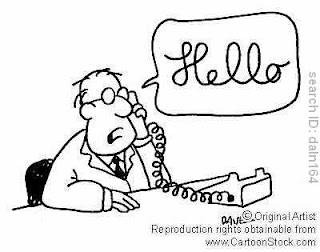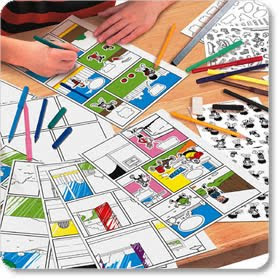1Practice drawing people, animals, backgrounds and props such as furniture, food items, TV set etc.
2Create characters. Choose catchy names for them. Experiment with all types of characters, not just ordinary people. Try super-humans, aliens, inanimate objects coming to life. And don't forget animals. Animals make excellent characters because they can mimic or enlarge certain characteristics that you want the character to portray. For example, an owl with a large head for a brainy character, a dog with a frown for a grouchy character or a hyena with a cheesy smile for a character who always sees the funny side of life.
3Think of a short, amusing tale or a humorous skit featuring a joke for your comic. Also make sure to adapt your jokes for the age group that you intend this comic for. For example, complicated jokes will be hard for young children to understand.
4Make a rough copy of your first comic. Use the tale or the joke to develop the storyline. A rough copy is a basic version of your comic, using stick figures or quick drawings to show what your comic strip is about.
5Find a good name for your comic. Make sure it goes with the subject of your comic.
6Make a good copy of your comic. A "good copy" is the real version of your comic, with all the detail and color completed. You can scan your comic into your computer and color it if you are computer savvy.
7Show the comic to family and friends. Ask them to read it. This will help you to gauge how funny and successful your comic is, which will guide your future comic-making.
8Keep your comic in a safe place because someday you might want to get it published.
+%20google_info.feedback_url%20+%20'">Ads by Google';
for(i = 0; i '+ '
'
+ google_ads[i].line1 + ' '
+ google_ads[i].line2 + ' ' + google_ads[i].line3 + '' +
'
' + google_ads[i].visible_url + '';
}
s += "";
document.write(s);
return;
}
google_ad_channel = '4065666674+7733764704+1640266093+9911500640+5009222491+6529619144+3607312525+8962074949+8941458308+7122150828';
google_ad_client = "pub-9543332082073187";
google_ad_output = 'js';
google_ad_type = 'text';
google_feedback = 'on';
google_ad_region = "test";
google_ad_format = "250x250_as";
//-->
google_protectAndRun("render_ads.js::google_render_ad", google_handleError, google_render_ad);
Ads by GoogleMake Free CartoonsIt's easy to create cartoons and animations with Sketch Star!
http://googleads.g.doubleclick.net/aclk?sa=l&ai=B7WKlhj4tS-CHI6WuzAWWwtDdAayD39sBxOaS-w7AjbcBsMwLEAEYAyCYv48FKAI4AFC-8Iu5AmDJtsuH4KO0EKABvMe4_gOyAQ93d3cud2lraWhvdy5jb226AQoyNTB4MjUwX2FzyAEB2gEwaHR0cDovL3d3dy53aWtpaG93LmNvbS9Xcml0ZS1hLUZ1bm55LUNvbWljLVN0cmlw4AECgAIBqAMB6AO-AugDtgH1AwAAAIQ&num=3&sig=AGiWqtz289THtsd7j1dCdMsEQ91ngguWWg&client=ca-pub-9543332082073187&adurl=http://www.miniclip.com/sketch-star2010: Improve Your EduDon't make another excuse. Get your online degree now. Enroll Today!
search-schools.comedit Tips
Start drawing rough copies with an erasable pencil and once you get better at doing this, you can draw the comic straight out, using just a pen and paper.
If you mess up your comic, don't get mad, just try again.
There is no harm looking at existing comic strips for ideas and style suggestions but don't copy. It is very important to develop your own style.
Sometimes families can be of great inspiration! Try portraying a funny moment or story in your comic. If you do this, though, make sure that it isn't too long, and it doesn't reference "inside jokes" or "running gags" with your family that would need to be explained, as these tend to make the comic far less funny.
Carry a notebook with you wherever you go. You never know when a funny idea will strike, so be ready to write it down, because chances are you'll forget it.
Not all comics are strips. You can do a "Sunday comic" (long, usually takes up a lot of room) or you can do a "weekday comic" (short, usually three to four panels), or even a one-panel comic! The New Yorker has a ton of these short gag comics.
If you tend to write long-winded comics and your artistic skill is salvageable, maybe you should look into a graphic novel. These, though extremely time consuming, can be very fun and rewarding to do.
Don't really go by what your parents say. Even if it is terrible they will tell you anything you do is great.
+%20google_info.feedback_url%20+%20'">Ads by Google';
for(i = 0; i '+ '
'
+ google_ads[i].line1 + ' '
+ google_ads[i].line2 + ' ' + google_ads[i].line3 + '' +
'
' + google_ads[i].visible_url + '';
}
s += "";
document.write(s);
return;
}
google_ad_channel = '7690275023+7733764704+1640266093+9911500640+5009222491+6529619144+3607312525+8962074949+8941458308+7122150828';
google_ad_client = "pub-9543332082073187";
google_ad_output = 'js';
google_ad_type = 'text';
google_feedback = 'on';
google_ad_region = "test";
google_ad_format = "250x250_as";
//-->
google_protectAndRun("render_ads.js::google_render_ad", google_handleError, google_render_ad);
Ads by GoogleInside A Boyfriends Mind10 Secrets To Get Your Boyfriend Positively Addicted To You For Life
CatchHimAndKeepHim.comComic Books for saleOrder many recent back issues now! Free shipping for orders over $100.
http://googleads.g.doubleclick.net/aclk?sa=l&ai=Bhr9Dhz4tS82vA4mIzAXh5_mJAZW-0KgBg9uIpxHAjbcB0LsbEAIYByCYv48FKAI4AFDk_sHoBmDJtsuH4KO0EKAB84WF9QOyAQ93d3cud2lraWhvdy5jb226AQoyNTB4MjUwX2FzyAEB2gEwaHR0cDovL3d3dy53aWtpaG93LmNvbS9Xcml0ZS1hLUZ1bm55LUNvbWljLVN0cmlw4AEDqAMB6AO-AugDtgH1AwAAAIQ&num=7&sig=AGiWqtxRCFT7FBbr73AR8r186QZQg_TMtQ&client=ca-pub-9543332082073187&adurl=http://www.comicsandcardsupplies.com












 Step 1Research what comic books you like. Note the style of the illustrations and what types of heroes and heroines are in these comic books. Comic books can vary widely, from futuristic space operas, to detective dramas, even to medieval adventures. Note the style of drawings and which ones seem to leap off the page at you. Strive to emulate the best parts of the comic books you love while creating your original world.
Step 1Research what comic books you like. Note the style of the illustrations and what types of heroes and heroines are in these comic books. Comic books can vary widely, from futuristic space operas, to detective dramas, even to medieval adventures. Note the style of drawings and which ones seem to leap off the page at you. Strive to emulate the best parts of the comic books you love while creating your original world.



